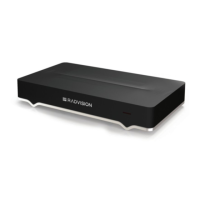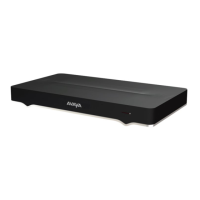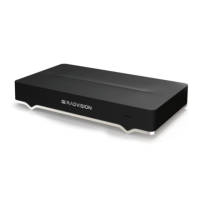Configuring Basic Network Settings
About this task
This procedure describes how to set up the basic network settings and the IP address of the XT
Series as part of the Quick Setup Wizard. To modify advanced network settings, see Deployment
Guide for Avaya XT Series.
Procedure
1. Access the Quick Setup Wizard from the endpoint, as described in
Configuring Basic
Settings with the Quick Setup Wizard on page 34, and skip to this step.
2. Enter the following values:
Table 4: Configuring the IP address
Field Name Description
IP Address Mode or
Automatic IP Address
Determines if the IP address is dynamically allocated (using DHCP), or
if you manually designate a static IP address. You must use only static
addresses for:
• Avaya Telepresence Platform deployments
• Units on a public network
• SIP deployments where the unit is secured with a TLS certificate, if
the certificate request has been tied to a specific IP address.
IP address Enter the system static IP address. For dynamic IP addresses, this field
displays the current IP address.
Subnet mask Enter the subnet mask associated with the IP address. For dynamic IP
addresses, this field displays the current subnet mask.
Gateway (IP Address) Enter the default gateway static IP address. The gateway is used to
route information between two subnets, for example, between the
headquarters and a partner site. For dynamic IP addresses, this field
displays the current gateway IP address.
DNS (Server IP
Address)
Enter the DNS server IP address. The DNS server translates domain
names into IP addresses. For dynamic IP addresses, this field displays
the assigned DNS server IP address.
For web collaboration and cloud connection to Avaya Equinox
®
Management, you must insert a valid DNS address.
3. Select Next and continue with one of the following, depending on whether you are
registering your endpoint to a gatekeeper or SIP server:
• If you are registering your endpoint to a gatekeeper, continue with Configuring Basic
Gatekeeper Settings on page 38.
• If you are only registering your endpoint to a SIP server (and not a gatekeeper),
continue with Configuring Basic SIP Settings on page 38.
Related links
Configuring Basic Settings with the Quick Setup Wizard on page 34
Applying basic settings
June 2019 Avaya IX Video Conferencing XT Series User Guide 37
Comments on this document? infodev@avaya.com

